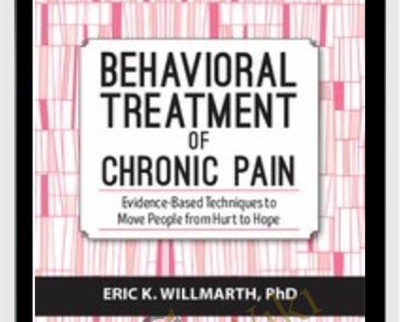$219.99 Original price was: $219.99.$83.00Current price is: $83.00.
We are in the midst of a nationwide push to treat chronic pain and address our out-of-control opioid prescribing. At least 1/3 of the people we treat are dealing with this condition, yet most of us are ill-prepared to address this with skill and expertise. The CDC recently published recommendations for the treatment of chronic pain, specifically highlighting behavioral treatment as an approach that should be tried before opioids are prescribed.
 Purchase this course you will earn 83 Points worth of $8.30
Purchase this course you will earn 83 Points worth of $8.30We are in the midst of a nationwide push to treat chronic pain and address our out-of-control opioid prescribing. At least 1/3 of the people we treat are dealing with this condition, yet most of us are ill-prepared to address this with skill and expertise. The CDC recently published recommendations for the treatment of chronic pain, specifically highlighting behavioral treatment as an approach that should be tried before opioids are prescribed.
We are witnessing a devastating public health crisis that is ruining individual’s lives, tearing up families, and ripping through communities. We need to arm ourselves with the skills needed to offer our clients evidence-based behavioral interventions that will help them live healthy and productive lives.
Purchase this cutting-edge recording and learn creative tools and techniques to transform your practice. Learn powerful mindfulness interventions and motivational interviewing techniques to move your clients toward behavior change. Master the four pain-changing CBT tools. You will finish this recording with the skills and confidence to provide practical and life-changing help to help people move out of chronic pain and into active, healthy, and meaningful lives.
- Describe how the emotional aspect of client’s pain can be more problematic than the physical aspect.
- Specify the differences in risks of opioid medications use in men, women and the elderly and the related treatment implications.
- Assess the psychological, physical, social, and behavioral factors that contribute to chronic pain and articulate their treatment implications.
- Implement motivational interviewing techniques to motivate clients toward behavioral change that reduce the symptoms of chronic pain.
- Summarize the CDC recommendations for the treatment of chronic pain and communicate how that impacts clinical treatment.
- Utilize mindfulness-based strategies to decrease symptoms of chronic pain in clients.
Pain
- Acute vs. chronic pain
- Emotional aspect of pain
- More problematic than physical aspect
- Anxiety, fear, catastrophizing
- ACE (Adverse Childhood Experiences)
- Study and link to pain
- Chronic pain onset: Physical & emotional
- Pain vs. suffering
- Impact of pain
- Prevalence
- Societal costs
- Chronic pain cycle
- Psychological
- Physical
- Factors that impact pain
- Physical, thought, emotions, behaviors
- Social interactions
- Suicidality and chronic pain
Opioids
- Scope of the problem
- The “painkiller” myth
- Not effective pain relief
- Medication assisted treatment
- Methadone
- Buprenorphine (Suboxone)
- Naltrexone injection (Vivitrol)
- Risks
- Men, women, elderly
Assessment
- Pain experience factors
- Psychological
- Behavioral
- Social
- Physical
- 5 E’s of pain interview
- Self-report measures
- Impact of pain
Treatment
- Treatment options
- Medication
- Invasive
- Non-invasive
- CDC guidelines
- Behavioral treatment first
- Importance of therapeutic relationship
- Mindfulness
- Powerful evidence-based interventions
- Motivational interviewing
- Proven techniques to move toward behavior change
- Goal-setting
- SMART goals
- Matching goals with client values
- CBT tools
- Automatic negative thoughts
- Thought distortions
- ABC worksheet
- Decatastrophizing
- Additional behavioral treatment tools
- Breathing
- Imagery
- Pleasant activities
- Progressive muscle relaxation
- Anger management
- Time-based pacing
- Stress management
- Sleep hygiene
Research limitations and risks of psychotherapeutic approaches
Get Behavioral Treatment of Chronic Pain: Evidence-Based Techniques to Move People from Hurt to Hope – Eric K. Willmarth, Only Price $87
Tag: Behavioral Treatment of Chronic Pain: Evidence-Based Techniques to Move People from Hurt to Hope – Eric K. Willmarth Review. Behavioral Treatment of Chronic Pain: Evidence-Based Techniques to Move People from Hurt to Hope – Eric K. Willmarth download. Behavioral Treatment of Chronic Pain: Evidence-Based Techniques to Move People from Hurt to Hope – Eric K. Willmarth discount.
Only logged in customers who have purchased this product may leave a review.
Related products
= 85 Points
Uncategorized
Managing Patient Emergencies: Critical Care Skills Every Nurse Must Know – Dr. Paul Langlois
= 85 Points
= 84 Points
= 125 Points
Uncategorized
= 85 Points
Uncategorized
Disordered Eating Behaviors: Identify and Treat the Underlying Trauma – Lori Kucharski
= 85 Points
= 85 Points
= 72 Points





Reviews
There are no reviews yet.